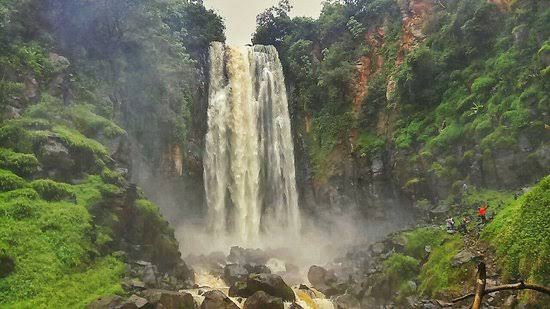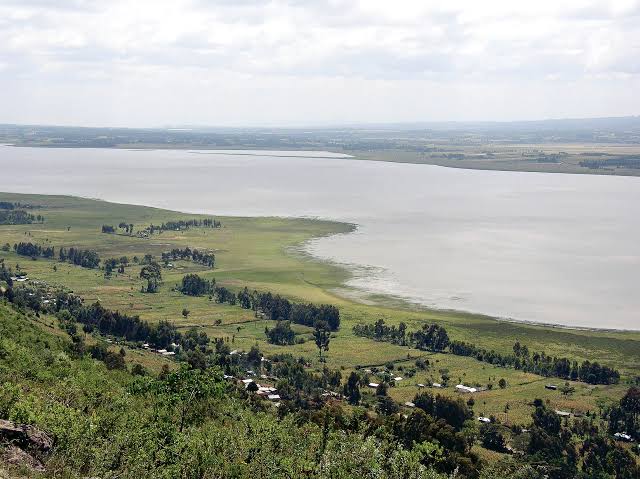NYANDARUA,Kenya, Mar, 31 – Lying at an altitude of 2,300 meters above sea level, Lake Ol Bolosat, the only Central highlands lake in Kenya and among the few found in the world, is under serious threat of extinction.
Found below the Aberdare ranges in Nyandarua County, the 43.3 square kilometer lake is home to more than 300 species of birds, migratory and resident, making it the 61st international bird area.
It is the source of water for the famous Thomson falls which forms river Ewaso Narok and later Ewaso Nyiro, which flows to Lorian swamp in Wajir County.
It is the home for the endangered Grey Crowned Crane birds.
George Ndung’u, an Ornithologist who has been involved in the conservation of the cranes, which have been listed as endangered by international union for conservation of nature (IUCN) tells us that the level of water in the lake has gone down drastically due to human activity, climate change and invasive species.
“We are worried about the level of water in Lake Olbolosat, it is going down every year for the past three years. Salvania Molesta, has invaded the lake and has covered much of the lake, affecting its biodiversity”, said Ndung’u.
With the situation being so dire,water levels have gone down drastically, so much so that one can ‘walk’ across the lake. In 2019,around the same time, one was forced to use a boat in order to cross from one side of the lake to the other.
With water now being scarce, Hippos are forced to idly lay in the mud at the lower part of the lake. Luxurious these animals enjoyed in the past are but distant memories.

The plant life, reeds, that served as cooling habitats and even places where they would often hide themselves from glaring eyes of possible predators are also long gone due to lack of adequate water. Instead, the giant salvinia plant also known as Salvania Molesta, an invasive specie is now threatening their lives.
Encroachment at the 30,000-acre lake is also a huge concern for the eco-system here. Only 9,000 acres remain uninhabited.
12,000 acres of the lake are meanwhile said to have been grabbed.
At the Lake’s riparian, a mansionette house is almost complete. It is not clear how someone could put up such an expensive house in a riparian land.
Dr. John Chumo, secretary general for National Environment Complains Committee, an environment Ombudsman says that after the lake was gazzeted for protection in 2018, NEMA has failed to act on saving it.
“Someone has a title deed for 10 acres of the lake, It is absurd that someone in his/her pocket has a title for a lake, this is total madness. There is a serious problem in Kenya”, said Dr. John Chumo.
Mary Waithera, the current County Executive for Lands, Mining and Naural resources at the county government of Nyandarua says that it is true that people have titles of riparian land, but they are unable to tell who issues them.
“There are people with titles around the lake, what I don’t know is whether they are legal or not”. Said Waithera.
Sources within the area say that those who have constructed homes at the lakes are devising ‘mischievous’ tricks to indicate that they have lived in the area for decades so as to boost their fortunes once plans of a possible compensation programme is mooted.
Efforts to get a comment regarding the issuance of title deeds from the Nyahururu town office meanwhile proved futile.
At the upper side of the lake, lies the Satima escarpment, which is an extension of the Aberdere and Ndaragua forests.
A road contractor has been in the area excavating for construction materials. Since it is at the upper part of the lake, massive soil is expected to find its way into the lake once it rains, thus causing more siltation.
Satima escarpment is critical to the survival of lake Olbolosat. It has 16 water streams that drain into the lake.
Part of the escapement has been on fire for several days and it is said to be caused by farmers who are preparing land for planting.
At the Thomson Falls, water levels are at their lowest. Locals here agree that over time things have drastically changed for the worst.
“Years ago you could not stand at this view point, people thought it was smoke and wondered where fire was from. Fog from the water falls was heavy, you could not stand here for long as you could get wet, and today we only have the memories”. Said, Samuel Munyito, a resident of Nyandarua County.

The falls forms Ewaso Narok river which flows through Marmanet forest, snaking its way to Ewaso Narok wetland in Laikipia County, at the outskirts of Rumuruti town.
Waters of Ewaso Narok river are low, a clear indication of what human activities in Lake Olbolosat ecosystem is affecting the downstream ecosystem.
At the Ewaso Narok wetland famously known as Marura, sounds of generators can be heard from a distance. It is a scramble for the water by farmers, herders and wildlife.
Farmers are using heavy generators to pump water from the wetland to their farms. Tomatoes are doing well despite the heat from the scorching sun. No water regulation here
One side of the swamp, you will find inmates from Rumuruti GK prison busy planting tomatoes and other vegetables.
On the other side of the wetland, herders are pushing their animals inside the reeds deep into the swamp. You can easily spot buffaloes inside the swamp. The reeds are from time to time set on fire to regenerate so that herders can feed their animals. This is a major threat to birds and wild animals that use the reeds as their habitat.
Not too far from the swamp is Aiyam River, which drains into the swamp. It has given up the fight for survival due to unregulated abstraction of water for farming.
The greater Ewaso Nyiro River begins its journey here, snaking through Laikipia, Isiolo, Samburu and Wajir counties, drining into Lorian swamp. More than 2 million people in those counties depend on the river for water.
Even before getting to Samburu National Reserve, the river is already dry. Here you will find elephants digging through the sand to try getting water to quench their thirst.
Buffalo Springs after Samburu National Reserve breathes life to Ewaso Nyiro River once again. But at Archers post, massive sand harvesting is taking place leaving Rocky River. This is the case of a crying river that has no one to save it.
The river can no longer flow into Lorian swamp as it drying before its destination.
People living in the drought ravaged counties of Isiolo, Samburu and Wajir hoped that the river was flowing. That could have eased their suffering to some extent.
Back to Ewaso Narok wetland, the ministry of environment on March,24, 2022 issued a thirty-day public notice of an intention to gazette the wetland for protection.
George Ndung’u and his team of birds conservationists are sensitizing the locals on the need to save Lake Olbolosat. They have so far planted 10,000 trees at the Satima escarpment to try save the springs that feeds the lake.
Concerted efforts are needed to save the gem of Central Kenya.
The writer, Dan Kaburu, is an environmental award winning journalist with K24TV. He has reported extensively on wildlife,climate change and conservation efforts in Kenya,Africa and the World.
Want to send us a story? Contact Shahidi News Tel: +254115512797 (Mobile & WhatsApp)


